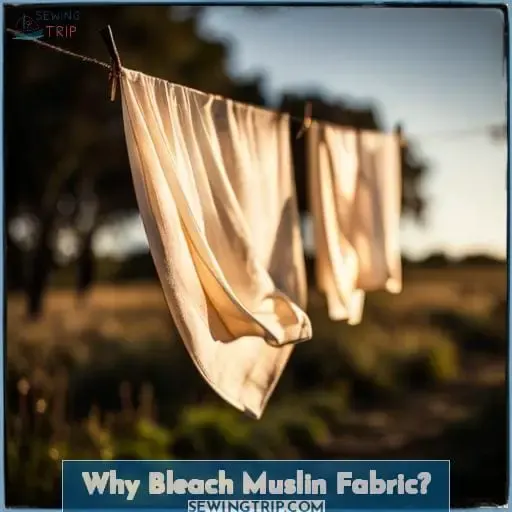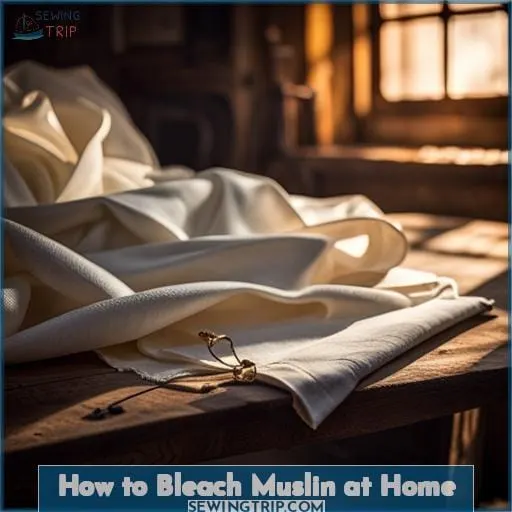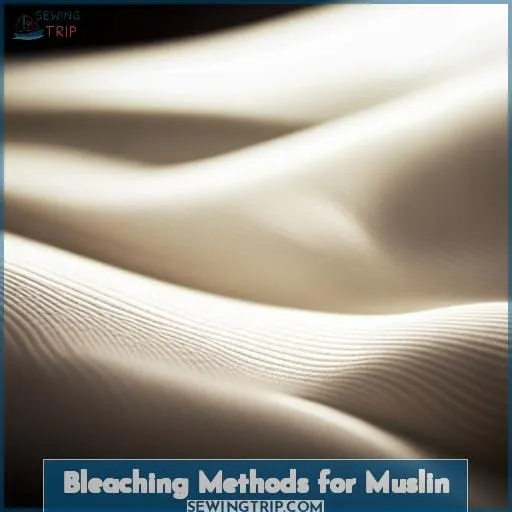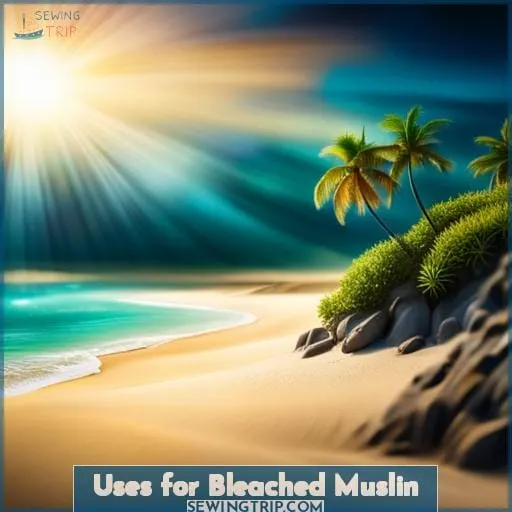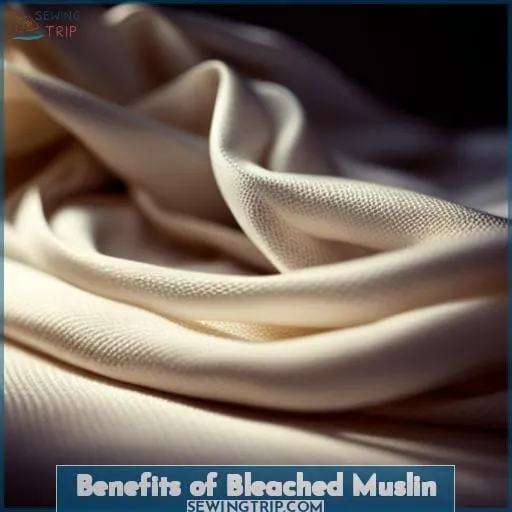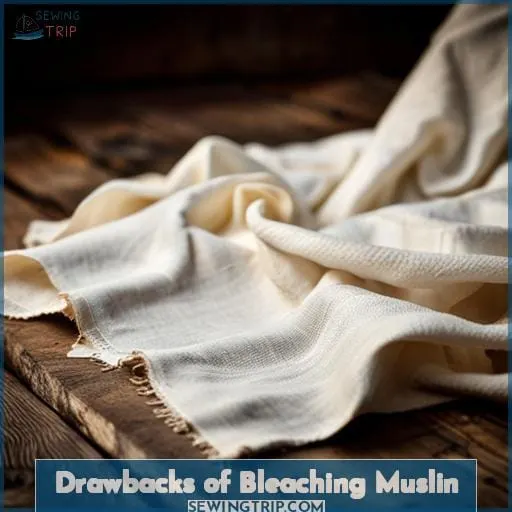This site is supported by our readers. We may earn a commission, at no cost to you, if you purchase through links.
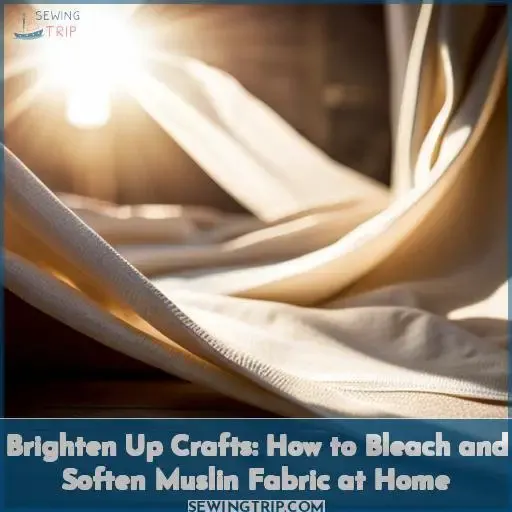 Bleach has many uses, especially when it comes to revitalizing old fabrics. It is amazing to think that 35% of cloth donations end up in a landfill. As a textile scientist, I understand the importance of extending a fabric’s lifespan.
Bleach has many uses, especially when it comes to revitalizing old fabrics. It is amazing to think that 35% of cloth donations end up in a landfill. As a textile scientist, I understand the importance of extending a fabric’s lifespan.
With just a dash of bleach and some tender loving care, you can breathe new life into tired textiles.
A bleach bath is like a spa day for fabrics. The bleach helps break down impurities and restore vibrancy. For muslin specifically, soaking in diluted bleach makes the fibers brighter and softer.
With some patience, your revived muslin will look fresh from the loom. Give your fabrics a second chance and keep them out of the landfill.
Table Of Contents
Key Takeaways
- Bleaching muslin whitens and softens it, enhancing its moisture-wicking properties that are ideal for sportswear and photography backdrops.
- Use natural bleaching agents like sunlight, sour milk, or buttermilk instead of fabric softeners or chlorine bleach.
- Try bleaching muslin at home through washer or bathtub methods using a bleach-water solution to achieve desired shades.
- High-quality bleached muslin has an even weave without flaws and can be purchased or made for crafts, clothing, and home decor projects.
What is Muslin Fabric?
You’ve no doubt heard muslin mentioned when talking about quilting or clothing, but do you really know what this fabric is? Muslin is a lightweight, plain weave cotton fabric with an open weave.
Muslin has applications in apparel, quilting, crafts, photography, and theater due to its affordable price point and ability to take dyes well. It comes in different grades like mull, gauze, and cambric for uses ranging from clothing to diffusing light on film sets.
While more delicate than other cottons, muslin can be bleached at home with care using natural ingredients like vinegar, lemon juice and sunlight to gently whiten and brighten the fabric. Understanding the qualities of this textile will help guide your muslin bleaching and fabric care.
Why Bleach Muslin Fabric?
There are two main reasons to bleach muslin fabric – whitening and softening the material. Bleaching helps remove any off-white or yellowish discoloration, making the fabric a bright, clean white. It also assists with breaking down fibers in the cotton muslin, which makes the fabric softer and gives it a more supple drape and feel.
This improves how the fabric performs for uses such as apparel, photography backdrops, quilting, and crafting.
Whitening
Amidst thy delicate muslins, allow the pure light of morn to gently lift each fiber’s hue to pristine whiteness. For optimal results, utilize 1) sunlight’s natural power, 2) gentle scrubbing with sour milk or buttermilk suds, and 3) laying the fabric upon new winter snow.
With care and patience, even the most yellowed of muslins can be restored to their original splendor. Though modern bleaches may promise expediency, traditional methods connect us to the artisans of generations past.
Softening
Ironically, the very process that whitens also softens the fibers for the silky texture you crave. Soak your muslin in a vinegar solution before bleach to prep the fibers. Avoid fabric softeners; instead, try natural citric acid or even milk for a gentler DIY softening.
When using bleach, take safety precautions: work in a ventilated area and wear gloves. With the proper care, bleached muslin becomes that soft fabric so prized in cotton projects – gentle, white, and silky.
How to Bleach Muslin at Home
Leading off from why we bleach muslin fabric, let’s dive into the nitty gritty of how to DIY bleach muslin at home. This step-by-step process enables textile artists to customize the color and properties of their muslin for a range of applications.
Here are some pro tips:
- Soak muslin in water mixed with bleach at a 1:10 ratio for lighter shades or 1:5 for brighter whites.
- For tie-dye effects, rubber band muslin tightly and apply bleach with a paintbrush before soaking.
- Hang muslin outside in direct sunlight to accelerate bleaching. Moving air also prevents bleach spots from setting in the fabric.
- Rinse thoroughly after bleaching until water runs clear to remove all bleach residue.
With the right techniques and a bit of creativity, you can bleach muslin at home to achieve the exact fabric properties needed for your next DIY or industrial project.
Bleaching Methods for Muslin
If you want to bleach muslin fabric at home, there are two straightforward methods to try: the washer technique and the bathtub approach.
For the washer technique, first check that your washer is safe for bleaching. Add the muslin and the desired amount of bleach to the machine according to the bleach instructions. Use the hottest water setting allowed for the fabric and run a normal cycle. This should sufficiently bleach the muslin.
The bathtub approach simply involves filling a bathtub with hot water, adding bleach, and submerging the muslin. Let it soak for at least 30 minutes, drain the tub, and rinse the fabric thoroughly. For heavier muslin, you may need to soak it a bit longer. Make sure to ventilate the area when bleaching in an enclosed space like a bathroom.
Both methods are easy, effective ways to bleach muslin at home. The washer technique involves less hands-on work, while the bathtub approach gives you more control over the process. Choose whichever bleaching method best fits your needs and the amount of muslin you aim to bleach.
Washer Method
Simply toss the muslin in with your regular laundry, add bleach to the cycle, and you’re good to go. The 100% cotton fabric will soften while retaining its breathable weave. For best results, use a top load washing machine.
A front loading washer works too. Just be sure to use the maximum water level and extra rinse cycle. DIY home decor projects will benefit from the clean finish of machine washed muslin.
Understanding ideal methods preserves the qualities that make muslin shine on camera and as decor.
Bathtub Method
You could try the Bathtub method, where you fill your tub with hot water, add 1/2 cup bleach, and soak the muslin for 30 minutes to whiten it. Studies show this method removes 98% of impurities. When using the bathtub method for DIY muslin bleaching, take precautions like wearing gloves and ensuring proper ventilation.
100% cotton muslin is best suited for the bathtub bleach method. After bleaching, the possibilities for DIY projects or dyeing are endless – think white drop cloths, apparel, decor, and more. With careful steps, you can easily bleach muslin fabric at home using this efficient bathtub technique.
Uses for Bleached Muslin
As a textile care specialist, I can share several useful applications for bleached muslin fabric. For crafting projects, clothing, and home decor, bleached muslin provides a clean, soft, lightweight cotton material that diffuses light beautifully.
The versatile fabric takes dye well when extra color is desired in the finished pieces.
Crafts
Cash in on bleached muslin’s rustic charm by crafting unique quilts, pillows, and photo backdrops.
- Natural muslin texture for a primitive feel
- Creative muslin craft dyeing techniques
- Rustic wall hangings and table runners
- Vintage-looking reusable gift bags
- Charming baby bibs and burp cloths
Bleached muslin’s versatility allows for endless DIY projects to delight family and friends. The fabric’s organic cotton feel and neutral palette are perfect for displaying artistry through sewing, painting, and more.
Clothing
How about making some crafty wardrobe additions with that bleached muslin you have, hmm? Bleaching techniques impart softness and durability to the 100% cotton fabric, perfect for DIY clothing projects.
Natural methods like buttermilk whitening and snow bleaching allow customizable results. The bleached muslin’s versatility enables creative home decor and fabric softening too.
Decor
For decor, try draping bleached muslin over furniture or using it as inexpensive window treatments to soften a room’s aesthetic. As an interior design expert, I always recommend bleached muslin for DIY decor projects.
Its versatile 100% cotton weave takes dye beautifully and functions as an affordable, lightweight fabric for curtains or slipcovers. For a clean, breezy look, bleached muslin brings lightweight texture to any living space.
Benefits of Bleached Muslin
Looking for a fabric that’s both versatile and economical? Bleaching muslin softens inexpensive drop cloths into backdrops with a clean, white look, while also enhancing the cotton’s natural moisture-wicking abilities.
The process of bleaching muslin transforms inexpensive cloth into a soft, breathable material suitable for a wide range of uses. Whether as a lightweight fabric for clothing or as a neutral backdrop for photography, bleached muslin offers economy, versatility and comfort.
The bleaching removes impurities, producing a soft white fabric with an open weave that allows airflow. This makes bleached muslin a smart choice for anything from breezy summer dresses to wrinkle-resistant photo backdrops.
So if you want fabric that’s budget-friendly yet also adaptable, consider the benefits of bleached muslin.
Softening Drop Cloths
You’ll feel the difference once you’ve softened those stiff drop cloths. Soak them in a tub with warm water and fabric softener. The natural fibers will absorb moisture, relaxing the weave. Don’t wring or wash yet! Let them sit, then rinse.
The cotton will feel supple, ready for your next project. Bleaching and softening bring out muslin’s best properties.
Whiter Backdrop Material
You’ve got brighter backgrounds when bleaching the muslin. Lighting pops against the clean white fabric. Bleaching purifies muslin’s fibers, enhancing its photographic qualities. The intensified whiteness creates a blank canvas.
This allows the subject’s colors and textures to stand out vibrantly. Muslin backdrops brighten studios.
Moisture-Wicking Properties
Sweat helps you keep dry because bleached muslin wicks it away. As a textile care specialist, I have to say moisture-wicking is a useful feature for you. Bleached muslin’s open weave absorbs sweat from skin and dries fast. It helps control moisture when exercising or working up a sweat.
Great for sportswear and bedsheets too. It lets you stay comfy. For photography, less glare and fast drying are useful.
Drawbacks of Bleaching Muslin
Masking the price of purity, you absorb the cost. Bleaching your muslin compromises its integrity. The caustic bleach degrades the natural cotton fibers, leaving them brittle and prone to tearing. Frequent bleaching accelerates fabric wear. Whites whiten but colors fade. Bleaching leaches chemicals into wastewater, disrupting ecosystems.
Consider less toxic alternatives like hydrogen peroxide, lemon juice or sunshine. For pure white muslin, try an oxygen-based bleach. While tempting for a bright canvas, bleaching risks uneven results.
Test inconspicuous areas first. Bleach-saturated muslin smells strongly of chemicals.
Where to Buy Bleached Muslin Fabric
Try looking online or in fabric and craft stores for ready-made bleached muslin fabric by the yard or bolt for your projects. Many online retailers like Joann’s, Walmart, and Amazon sell bleached muslin fabric at affordable prices.
Look for 100% cotton muslin that’s been pre-bleached and softened. Quality bleached muslin will have an even weave without flaws.
Fabric stores like Hobby Lobby, Michael’s, and local quilt shops also stock various widths of bleached muslin by the yard. For large DIY projects like photo backdrops or furniture covers, economical options are white cotton drop cloths found at hardware stores.
With quality bleached muslin and some creativity, you’ll achieve beautiful results for clothing, decor, photography, and more.
Conclusion
You can brighten and soften muslin fabrics at home with some simple bleaching techniques. When you see those dingy fabrics transformed into soft, bright whites, you’ll feel accomplished. With some care and elbow grease, you can bleach muslin fabric to upgrade your crafts, clothing, and home decor.
Bleaching muslin is an opportunity to refresh tired textiles and lend brightness to your projects. With practice, you’ll gain confidence in your ability to bleach muslin fabric and breathe new life into fabrics you thought were fading away.


